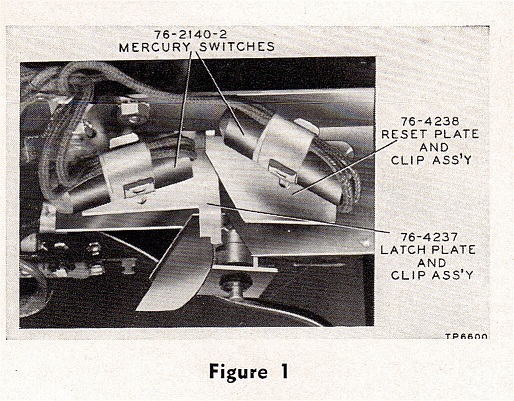06-23-2013, 07:42 PM
I'm currently restoring a beautifully preserved Model M-15 Philco album length record player. Philco's first 33 1/3 rpm record player, introduced in June of 1948.
It is a single play (single record, no changer) player, and the "on / off" switch is the tone arm. Move the tone arm off of the stand, and the turntable starts to spin. Place it back on the stand, and it stops. At least that's the way it's supposed to work.
When I got this unit, I replaced the two capacitors and checked it over. The motor was free, the underside was spotless.. it looked showroom new under there. So, with breath held, I plugged it in. And.. nothing. I turned the player on its side to get a look underneath, and the motor started to work. I tipped it back down and the motor kept spinning... until I had it tipped about 30 degrees from being flat. Then it quit again.
So, as much as I didn't want to disturb them, I knew the problem lied within the two mercury switches that control on & off. What I found may also help others who have Philco phonographs that use mercury switches to control when the turntable starts and / or stops spinning. Those with model 1201's and 1401's, this is especially applicable.
I took a pencil and marked the mercury switch on each side of the clip that holds them in place so I could put them back in exactly the same place if need be. I also numbered them and numbered the clip which held them to prevent them getting mixed up. I found I had to move EACH of the two mercury switches almost a 1/4 inch further out from their original position in the clamp to get them to function correctly again. My theory, and I may be totally off on this, but things may have settled over time inside the switches, and the little blob of mercury that rolls back and forth as the switches are tilted may not be in the same place as it was in this case 65 years ago.
Here's a close up of the mechanism on this phonograph. When the tone arm is removed from the stand, the two mercury switches tilt downward, thus starting the turntable motor. When the tone arm is placed back on the stand, the switches move up to a horizontal position, shutting off the turntable.

Just something I discovered by accident that I thought may be an option to try for others. If you mark exactly where the mercury switches were positioned and located, you don't have to be afraid to move them around because you can't mess anything up. You can always go back to the way it was originally.
It is a single play (single record, no changer) player, and the "on / off" switch is the tone arm. Move the tone arm off of the stand, and the turntable starts to spin. Place it back on the stand, and it stops. At least that's the way it's supposed to work.
When I got this unit, I replaced the two capacitors and checked it over. The motor was free, the underside was spotless.. it looked showroom new under there. So, with breath held, I plugged it in. And.. nothing. I turned the player on its side to get a look underneath, and the motor started to work. I tipped it back down and the motor kept spinning... until I had it tipped about 30 degrees from being flat. Then it quit again.
So, as much as I didn't want to disturb them, I knew the problem lied within the two mercury switches that control on & off. What I found may also help others who have Philco phonographs that use mercury switches to control when the turntable starts and / or stops spinning. Those with model 1201's and 1401's, this is especially applicable.
I took a pencil and marked the mercury switch on each side of the clip that holds them in place so I could put them back in exactly the same place if need be. I also numbered them and numbered the clip which held them to prevent them getting mixed up. I found I had to move EACH of the two mercury switches almost a 1/4 inch further out from their original position in the clamp to get them to function correctly again. My theory, and I may be totally off on this, but things may have settled over time inside the switches, and the little blob of mercury that rolls back and forth as the switches are tilted may not be in the same place as it was in this case 65 years ago.
Here's a close up of the mechanism on this phonograph. When the tone arm is removed from the stand, the two mercury switches tilt downward, thus starting the turntable motor. When the tone arm is placed back on the stand, the switches move up to a horizontal position, shutting off the turntable.
Just something I discovered by accident that I thought may be an option to try for others. If you mark exactly where the mercury switches were positioned and located, you don't have to be afraid to move them around because you can't mess anything up. You can always go back to the way it was originally.
Greg V.
West Bend, WI
Member WARCI.org



![[-] [-]](https://philcoradio.com/phorum/images/bootbb/collapse.png)


